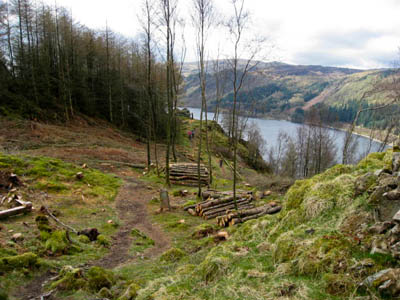
The tree clearance on Great How
A conservation group has funded a project to provide a better view of a reservoir whose creation was fought by the group’s founding fathers more than a hundred years ago.
Walkers can now enjoy panoramic views of Thirlmere, along with Helvellyn, Skiddaw and Blencathra from the top of Great How, at the north-east corner of the Lakeland reservoir. The Friends of the Lake District provided cash for clearing trees from the summit of the 330m (1,083ft) hill.
Larch trees planted in the 1950s have been felled from the top of the wooded knoll. Owners United Utilities hope to restore a native oak woodland on the site. The trees have been cleared from the top and east side of the hill, allowing views of the Helvellyn range and Skiddaw and Blencathra to the North.
Great How is also a favoured spot of military plane-spotters as the regular training route for pilots enables relatively close viewing of low-flying aircraft.
The irony of the grant from the Friends is that the founders of the group originally came together to fight the creation of a reservoir at Thirlmere. The battle was lost with the construction of a dam at the northern end of the valley, next to Great How, to merge two smaller lakes Leathes Water and Wythburn Water, to supply Manchester’s population. The Friends of the Lake District was formed in 1934 and celebrates its 75th anniversary this year.
Jack Ellerby, policy officer with Friends of the Lake District said: “The summit of Great How has been transformed opening up spectacular views to the northern fells and south down the full length of the Thirlmere, views which have been hidden for many years.
“We hope to make the whole of Great How as important in terms of wildlife, ecology and habitat as the lower eastern slopes, which are already a recognized as a Site of Special Scientific Interest.”
Paul Clavey, woodland officer for United Utilities said: “Some people worry when trees are cut down but this work at Great How makes sense for several reasons. Many of the trees were inaccessible and so of little economic value. We wanted to extend the important upland oak woodland wildlife habitat and the views from the top were being obscured each year as the trees grew taller.”
However, the panorama won’t last forever. Native tree species such as oak, birch and ash are expected to re-establish themselves following the clearance.